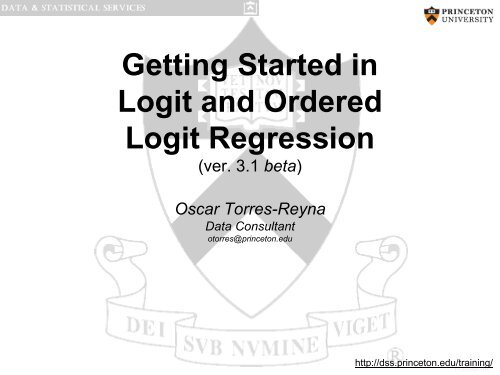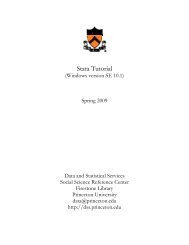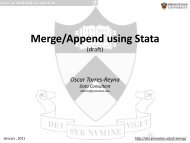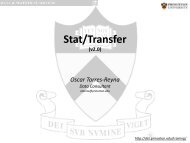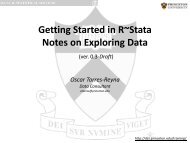Getting Started in Logit and Ordered Logit Regression - Data and ...
Getting Started in Logit and Ordered Logit Regression - Data and ...
Getting Started in Logit and Ordered Logit Regression - Data and ...
You also want an ePaper? Increase the reach of your titles
YUMPU automatically turns print PDFs into web optimized ePapers that Google loves.
<strong>Gett<strong>in</strong>g</strong> <strong>Started</strong> <strong>in</strong><br />
<strong>Logit</strong> <strong>and</strong> <strong>Ordered</strong><br />
<strong>Logit</strong> <strong>Regression</strong><br />
(ver. 3.1 beta)<br />
Oscar Torres-Reyna<br />
<strong>Data</strong> Consultant<br />
otorres@pr<strong>in</strong>ceton.edu<br />
http://dss.pr<strong>in</strong>ceton.edu/tra<strong>in</strong><strong>in</strong>g/<br />
PU/DSS/OTR
•<br />
•<br />
•<br />
<strong>Logit</strong><br />
model<br />
Use logit models whenever your dependent<br />
variable is b<strong>in</strong>ary (also called dummy) which<br />
takes values 0 or 1.<br />
<strong>Logit</strong> regression is a nonl<strong>in</strong>ear regression model<br />
that forces the output (predicted values) to be<br />
either 0 or 1.<br />
<strong>Logit</strong> models estimate the probability of your<br />
dependent variable to be 1 (Y=1). This is the<br />
probability that some event happens.<br />
PU/DSS/OTR
From Stock & Watson, key concept 9.3. The logit<br />
Pr( Y = 1|<br />
X1,<br />
X 2,...<br />
X<br />
Pr( Y = 1|<br />
X1,<br />
X 2,...<br />
X<br />
Pr( Y<br />
=<br />
1|<br />
X1,<br />
X<br />
2,...<br />
X<br />
k<br />
k<br />
k<br />
) = F(<br />
β + β X1+<br />
β X 2 + ... + β X<br />
0<br />
) =<br />
1+<br />
e<br />
) =<br />
⎛<br />
1+<br />
⎜<br />
⎝ e<br />
0<br />
0<br />
1<br />
1<br />
1<br />
1<br />
−(<br />
β + β X 1+<br />
β X 2+<br />
... + β X<br />
2<br />
1<br />
1<br />
( β + β X 1+<br />
β X 2+<br />
... + β X<br />
2<br />
2<br />
model is:<br />
K<br />
K<br />
K<br />
K<br />
)<br />
)<br />
⎞<br />
⎟<br />
⎠<br />
K<br />
K<br />
<strong>Logit</strong><br />
<strong>Logit</strong> <strong>and</strong> probit models are basically the same, the difference is <strong>in</strong> the<br />
distribution:<br />
• <strong>Logit</strong><br />
• Probit<br />
–<br />
–<br />
Cumulative st<strong>and</strong>ard logistic distribution (F)<br />
Cumulative st<strong>and</strong>ard normal distribution (Φ)<br />
Both models provide similar results.<br />
)<br />
model<br />
PU/DSS/OTR
In Stata you run the model as follows:<br />
Dependent<br />
variable<br />
<strong>Logit</strong> coefficients are <strong>in</strong> log-odds units<br />
<strong>and</strong> cannot be read as regular OLS<br />
coefficients. To <strong>in</strong>terpret you need to<br />
estimate the predicted probabilities of<br />
Y=1 (see next page)<br />
Independent<br />
variable(s)<br />
. logit y_b<strong>in</strong> x1 x2 x3 x4 x5 x6 x7<br />
Iteration 0: log likelihood = -251.9712<br />
Iteration 1: log likelihood = -192.3814<br />
Iteration 2: log likelihood = -165.56847<br />
Iteration 3: log likelihood = -160.76756<br />
Iteration 4: log likelihood = -160.44413<br />
Iteration 5: log likelihood = -160.442<br />
Logistic regression Number of obs = 490<br />
LR chi2(7) = 183.06<br />
Prob > chi2 = 0.0000<br />
Log likelihood = -160.442 Pseudo R2 = 0.3633<br />
y_b<strong>in</strong> Coef. Std. Err. z P>|z| [95% Conf. Interval]<br />
x1 .2697623 .1759677 1.53 0.125 -.0751281 .6146527<br />
x2 -.2500592 .1459846 -1.71 0.087 -.5361837 .0360653<br />
x3 .1150445 .1486181 0.77 0.439 -.1762417 .4063306<br />
x4 .3649722 .153434 2.38 0.017 .0642472 .6656973<br />
x5 -.3131214 .1467796 -2.13 0.033 -.6008042 -.0254386<br />
x6 -.1361499 .1566993 -0.87 0.385 -.4432749 .1709752<br />
x7 3.206987 .3631481 8.83 0.000 2.495229 3.918744<br />
_cons 1.58614 .39927 3.97 0.000 .803585 2.368695<br />
Note: 1 failure <strong>and</strong> 1 success completely determ<strong>in</strong>ed.<br />
Test the hypothesis that each coefficient is different<br />
from 1. To reject this, the t-value has to be higher<br />
than 1.96 (for a 95% confidence). If this is the case<br />
then you can say that the variable has a significant<br />
<strong>in</strong>fluence on your dependent variable (y). The higher<br />
the z the higher the relevance of the variable.<br />
<strong>Logit</strong><br />
model<br />
If this number is < 0.05<br />
then your model is ok. This<br />
is a test to see whether all<br />
the coefficients <strong>in</strong> the<br />
model are different than<br />
zero.<br />
Two-tail p-values test the<br />
hypothesis that each<br />
coefficient is different from 0.<br />
To reject this, the p-value<br />
has to be lower than 0.05<br />
(95%, you could choose also<br />
an alpha of 0.10), if this is<br />
the case then you can say<br />
that the variable has a<br />
significant <strong>in</strong>fluence on your<br />
dependent variable (y)<br />
PU/DSS/OTR
After runn<strong>in</strong>g the model:<br />
logit y_b<strong>in</strong> x1 x2 x3 x4 x5 x6 x7<br />
Type<br />
<strong>Logit</strong>: predicted probabilities<br />
predict y_b<strong>in</strong>_hat /*These are the predicted probabilities of Y=1 */<br />
Here are the estimations for the first five cases, type:<br />
browse y_b<strong>in</strong> x1 x2 x3 x4 x5 x6 x7 y_b<strong>in</strong>_hat<br />
Pr( Y = 1|<br />
X<br />
1<br />
, X<br />
2<br />
1<br />
1<br />
Predicted probabilities<br />
To estimate the probability of Y=1 for the first row, replace the values of X<br />
<strong>in</strong>to the logit regression equation. For the first case, given the values of X<br />
there is 79% probability that Y=1:<br />
,... X 7)<br />
=<br />
⎛<br />
1+<br />
⎜<br />
⎝ e<br />
( 1.<br />
58+<br />
0.<br />
26 X −.<br />
25 X + 0.<br />
11X<br />
+ 0.<br />
36 X −0.<br />
31X<br />
−0.<br />
13X<br />
+ 3.<br />
20 X<br />
1<br />
2<br />
3<br />
4<br />
5<br />
6<br />
7<br />
)<br />
⎞<br />
⎟<br />
⎠<br />
=<br />
0.<br />
7841014<br />
PU/DSS/OTR
. logit y_b<strong>in</strong> x1 x2 x3 x4 x5 x6 x7, or<br />
Iteration 0: log likelihood = -251.9712<br />
Iteration 1: log likelihood = -192.3814<br />
Iteration 2: log likelihood = -165.56847<br />
Iteration 3: log likelihood = -160.76756<br />
Iteration 4: log likelihood = -160.44413<br />
Iteration 5: log likelihood = -160.442<br />
Logistic regression Number of obs = 490<br />
LR chi2(7) = 183.06<br />
Prob > chi2 = 0.0000<br />
Log likelihood = -160.442 Pseudo R2 = 0.3633<br />
y_b<strong>in</strong> Odds Ratio Std. Err. z P>|z| [95% Conf. Interval]<br />
x1 1.309653 .2304567 1.53 0.125 .9276246 1.849014<br />
x2 .7787547 .1136862 -1.71 0.087 .5849765 1.036724<br />
x3 1.121923 .1667381 0.77 0.439 .8384153 1.501299<br />
x4 1.440474 .2210176 2.38 0.017 1.066356 1.945847<br />
x5 .7311612 .1073196 -2.13 0.033 .5483705 .9748823<br />
x6 .8727118 .1367534 -0.87 0.385 .6419307 1.186461<br />
x7 24.70453 8.971405 8.83 0.000 12.12451 50.33718<br />
Note: 1 failure <strong>and</strong> 1 success completely determ<strong>in</strong>ed.<br />
They represent the odds of Y=1 when X<br />
<strong>in</strong>creases by 1 unit. These are the exp(logit<br />
coeff).<br />
If the OR > 1 then the odds of Y=1 <strong>in</strong>creases<br />
If the OR < 1 then the odds of Y=1 decreases<br />
Look at the sign of the logit coefficients<br />
Test the hypothesis that each coefficient is different<br />
from 0. To reject this, the t-value has to be higher<br />
than 1.96 (for a 95% confidence). If this is the case<br />
then you can say that the variable has a significant<br />
<strong>in</strong>fluence on your dependent variable (y). The higher<br />
the z the higher the relevance of the variable.<br />
<strong>Logit</strong>: Odds ratio<br />
You can request odds ratio rather than logit coefficients by add<strong>in</strong>g the option or (after comma)<br />
Dependent<br />
variable<br />
Independent<br />
variable(s)<br />
<strong>Gett<strong>in</strong>g</strong><br />
odds ratios<br />
If this number is < 0.05 then<br />
your model is ok. This is a<br />
test to see whether all the<br />
coefficients <strong>in</strong> the model are<br />
different than zero.<br />
Two-tail p-values test the<br />
hypothesis that each coefficient<br />
is different from 0. To reject this,<br />
the p-value has to be lower than<br />
0.05 (95%, you could choose<br />
also an alpha of 0.10), if this is<br />
the case then you can say that<br />
the variable has a significant<br />
<strong>in</strong>fluence on your dependent<br />
variable (y)<br />
PU/DSS/OTR
<strong>Logit</strong>: adjust<br />
After runn<strong>in</strong>g the logit model you can estimate predicted probabilities or<br />
odds ratios by different levels of a variable (<strong>in</strong> particular for categorical or<br />
nom<strong>in</strong>al variables). You can also use the comm<strong>and</strong> prvalue expla<strong>in</strong>g at<br />
the end of the document.<br />
Us<strong>in</strong>g the comm<strong>and</strong> adjust.<br />
Odds ratio per different levels of variable<br />
x1. For example, when x1 = 1 the odds of<br />
Y=1 <strong>in</strong>crease by a factor of 7.8 (controll<strong>in</strong>g<br />
by the other X’s)<br />
. adjust, by(x1) exp<br />
Dependent variable: y_b<strong>in</strong> Comm<strong>and</strong>: logi<br />
Variables left as is: x2, x3, x4, x5, x6, x7<br />
x1 exp(xb)<br />
1 7.82314<br />
2 10.3279<br />
3 7.29768<br />
Key: exp(xb) = exp(xb)<br />
NOTE: Please see http://www.ats.ucla.edu/stat/Stata/library/odds_ratio_logistic.htm<br />
Predicted probabilities per different levels<br />
of variable x1. For example, when<br />
x1 = 1 the probability of Y=1 is 88%<br />
(controll<strong>in</strong>g by the other X’s)<br />
. adjust, by(x1) pr<br />
Dependent variable: y_b<strong>in</strong> Comm<strong>and</strong>: logit<br />
Variables left as is: x2, x3, x4, x5, x6, x7<br />
x1 pr<br />
1 .886662<br />
2 .911723<br />
3 .879484<br />
Key: pr = Probability<br />
PU/DSS/OTR
Ord<strong>in</strong>al logit<br />
When a dependent variable has more than two<br />
categories <strong>and</strong> the values of each category have a<br />
mean<strong>in</strong>gful sequential order where a value is<br />
<strong>in</strong>deed ‘higher’ than the previous one, then you<br />
can use ord<strong>in</strong>al logit.<br />
Here is an example of the type of variable:<br />
. tab y_ord<strong>in</strong>al<br />
Agreement<br />
level Freq. Percent Cum.<br />
Disagree 190 38.78 38.78<br />
Neutral 104 21.22 60.00<br />
Agree 196 40.00 100.00<br />
Total 490 100.00<br />
PU/DSS/OTR
<strong>Logit</strong> coefficients<br />
are <strong>in</strong> log-odds<br />
units <strong>and</strong> cannot be<br />
read as regular<br />
OLS coefficients.<br />
To <strong>in</strong>terpret you<br />
need to estimate<br />
the predicted<br />
probabilities of Y=1<br />
(see next page)<br />
Dependent<br />
variable Independent<br />
variable(s)<br />
. ologit y_ord<strong>in</strong>al x1 x2 x3 x4 x5 x6 x7<br />
Iteration 0: log likelihood = -520.79694<br />
Iteration 1: log likelihood = -475.83683<br />
Iteration 2: log likelihood = -458.82354<br />
Iteration 3: log likelihood = -458.38223<br />
Iteration 4: log likelihood = -458.38145<br />
<strong>Ordered</strong> logistic regression Number of obs = 490<br />
LR chi2( 7) = 124.83<br />
Prob > chi2 = 0.0000<br />
Log likelihood = -458.38145 Pseudo R2 = 0.1198<br />
y_ord<strong>in</strong>al Coef. Std. Err. z P>|z| [95% Conf. Interval]<br />
x1 .220828 .0958182 2.30 0.021 .0330279 .4086282<br />
x2 -.0543527 .0899153 -0.60 0.546 -.2305834 .1218779<br />
x3 .1066394 .0925103 1.15 0.249 -.0746775 .2879563<br />
x4 .2247291 .0913585 2.46 0.014 .0456697 .4037885<br />
x5 -.2920978 .0910174 -3.21 0.001 -.4704886 -.113707<br />
x6 .0034756 .0860736 0.04 0.968 -.1652255 .1721767<br />
x7 1.566211 .1782532 8.79 0.000 1.216841 1.915581<br />
/cut1 -.5528058 .103594 -.7558463 -.3497654<br />
/cut2 .5389237 .1027893 .3374604 .740387<br />
Note: 1 observation completely determ<strong>in</strong>ed. St<strong>and</strong>ard errors questionable.<br />
Ancillary parameters to def<strong>in</strong>e the<br />
changes among categories (see next<br />
page)<br />
Test the hypothesis that each coefficient is different<br />
from 1. To reject this, the t-value has to be higher<br />
than 1.96 (for a 95% confidence). If this is the case<br />
then you can say that the variable has a significant<br />
<strong>in</strong>fluence on your dependent variable (y). The higher<br />
the z the higher the relevance of the variable.<br />
Ord<strong>in</strong>al logit: the setup<br />
If this number is < 0.05 then<br />
your model is ok. This is a<br />
test to see whether all the<br />
coefficients <strong>in</strong> the model are<br />
different than zero.<br />
Two-tail p-values test the<br />
hypothesis that each<br />
coefficient is different from<br />
0. To reject this, the p-value<br />
has to be lower than 0.05<br />
(95%, you could choose<br />
also an alpha of 0.10), if this<br />
is the case then you can say<br />
that the variable has a<br />
significant <strong>in</strong>fluence on your<br />
dependent variable (y)<br />
PU/DSS/OTR
Ord<strong>in</strong>al logit: predicted probabilities<br />
Follow<strong>in</strong>g Hamilton, 2006, p.279, ologit estimates a score, S, as a l<strong>in</strong>ear function of the<br />
X’s:<br />
S = 0.22X 1<br />
-0.05X 2<br />
Predicted probabilities are estimated as:<br />
+ 0.11X3 + 0.22X4 -0.29X 5<br />
+ 0.003X6 + 1.57X7 P(y_ord<strong>in</strong>al=“disagree”) = P(S + u ≤ _cut1) = P(S + u ≤ -0.5528058)<br />
P(y_ord<strong>in</strong>al=“neutral”) = P(_cut1 < S + u ≤ _cut2) = P(-0.5528058 < S + u ≤ 0.5389237)<br />
P(y_ord<strong>in</strong>al=“agree”) = P(_cut2 < S + u ) = P(0.5389237 < S + u)<br />
To estimate predicted probabilities type predict right after ologit model. Unlike<br />
logit, this time you need to specify the predictions for all categories <strong>in</strong> the ord<strong>in</strong>al<br />
variable (y_ord<strong>in</strong>al), type:<br />
predict disagree neutral agree<br />
PU/DSS/OTR
To read these probabilities, as an example, type<br />
Ord<strong>in</strong>al logit: predicted probabilities<br />
browse country disagree neutral agree if year==1999<br />
In 1999 there is a 62% probability of ‘agreement’ <strong>in</strong> Australia compared to 58% probability <strong>in</strong><br />
‘disagreement’ <strong>in</strong> Brazil while Denmark seems to be quite undecided.<br />
PU/DSS/OTR
. prvalue<br />
ologit: Predictions for y_ord<strong>in</strong>al<br />
Confidence <strong>in</strong>tervals by delta method<br />
Predicted probabilities: us<strong>in</strong>g prvalue<br />
After run<strong>in</strong>g ologit (or logit) you can use the comm<strong>and</strong> prvalue to estimate the probabilities for<br />
each event.<br />
Prvalue is a user-written comm<strong>and</strong>, if you do not have it type f<strong>in</strong>dit spost , select<br />
spost9_ado from http://www.<strong>in</strong>diana.edu/~jslsoc/stata <strong>and</strong> click on “(click<br />
here to <strong>in</strong>stall)”<br />
If you type prvalue without any option you will get the probabilities for each category when all<br />
<strong>in</strong>dependent values are set to their mean values.<br />
95% Conf. Interval<br />
Pr(y=Disagree|x): 0.3627 [ 0.3159, 0.4094]<br />
Pr(y=Neutral|x): 0.2643 [ 0.2197, 0.3090]<br />
Pr(y=Agree|x): 0.3730 [ 0.3262, 0.4198]<br />
x1 x2 x3 x4 x5 x6 x7<br />
x= 2.0020408 -8.914e-10 -1.620e-10 -1.212e-10 2.539e-09 -9.744e-10 -6.040e-10<br />
You can also estimate probabilities for a particular profile (type help prvalue for more details).<br />
. prvalue , x(x1=1 x2=3 x3=0 x4=-1 x5=2 x6=2 x6=9 x7=4)<br />
ologit: Predictions for y_ord<strong>in</strong>al<br />
Confidence <strong>in</strong>tervals by delta method<br />
95% Conf. Interval<br />
Pr(y=Disagree|x): 0.0029 [-0.0033, 0.0090]<br />
Pr(y=Neutral|x): 0.0055 [-0.0061, 0.0172]<br />
Pr(y=Agree|x): 0.9916 [ 0.9738, 1.0094]<br />
x1 x2 x3 x4 x5 x6 x7<br />
x= 1 3 0 -1 2 9 4<br />
For more <strong>in</strong>fo go to: http://www.ats.ucla.edu/stat/stata/dae/probit.htm<br />
PU/DSS/OTR
Predicted probabilities: us<strong>in</strong>g prvalue<br />
If you want to estimate the impact on the probability by chang<strong>in</strong>g values you can use the options<br />
save <strong>and</strong> dif (type help prvalue for more details)<br />
. prvalue , x(x1=1) save<br />
ologit: Predictions for y_ord<strong>in</strong>al<br />
Confidence <strong>in</strong>tervals by delta method<br />
95% Conf. Interval<br />
Pr(y=Disagree|x): 0.3837 [ 0.3098, 0.4576]<br />
Pr(y=Neutral|x): 0.2641 [ 0.2195, 0.3087]<br />
Pr(y=Agree|x): 0.3522 [ 0.2806, 0.4238]<br />
x1 x2 x3 x4 x5 x6 x7<br />
x= 1 -8.914e-10 -1.620e-10 -1.212e-10 2.539e-09 -9.744e-10 -6.040e-10<br />
. prvalue , x(x1=2) dif<br />
ologit: Change <strong>in</strong> Predictions for y_ord<strong>in</strong>al<br />
Confidence <strong>in</strong>tervals by delta method<br />
Current Saved Change 95% CI for Change<br />
Pr(y=Disagree|x): 0.3627 0.3837 -0.0210 [-0.0737, 0.0317]<br />
Pr(y=Neutral|x): 0.2643 0.2641 0.0003 [-0.0026, 0.0031]<br />
Pr(y=Agree|x): 0.3730 0.3522 0.0208 [-0.0299, 0.0714]<br />
x1 x2 x3 x4 x5 x6 x7<br />
Current= 2 -8.914e-10 -1.620e-10 -1.212e-10 2.539e-09 -9.744e-10 -6.040e-10<br />
Saved= 1 -8.914e-10 -1.620e-10 -1.212e-10 2.539e-09 -9.744e-10 -6.040e-10<br />
Diff= 1 0 0 0 0 0 0<br />
NOTE: You can do the<br />
same with logit or probit<br />
models<br />
Probabilities when x1=1 <strong>and</strong> all other<br />
<strong>in</strong>dependent variables are held at their mean<br />
values. Notice the save option.<br />
Probabilities when x1=2 <strong>and</strong> all other<br />
<strong>in</strong>dependent variables are held at their mean<br />
values. Notice the dif option.<br />
Here you can see the impact of x1 when it changes from 1 to 2.<br />
For example, the probability of y=Agree goes from 35% to 37% when<br />
x1 changes from 1 to 2 (<strong>and</strong> all other <strong>in</strong>dependent variables are held<br />
at their constant mean values.<br />
PU/DSS/OTR
Useful l<strong>in</strong>ks / Recommended books<br />
•<br />
•<br />
•<br />
•<br />
•<br />
•<br />
Books<br />
•<br />
•<br />
•<br />
•<br />
•<br />
•<br />
•<br />
DSS Onl<strong>in</strong>e Tra<strong>in</strong><strong>in</strong>g Section http://dss.pr<strong>in</strong>ceton.edu/tra<strong>in</strong><strong>in</strong>g/<br />
UCLA Resources to learn <strong>and</strong> use STATA http://www.ats.ucla.edu/stat/stata/<br />
DSS help-sheets for STATA http://dss/onl<strong>in</strong>e_help/stats_packages/stata/stata.htm<br />
Introduction to Stata (PDF), Christopher F. Baum, Boston College, USA. “A 67-page description of<br />
Stata, its key features <strong>and</strong> benefits, <strong>and</strong> other useful <strong>in</strong>formation.”<br />
http://fmwww.bc.edu/GStat/docs/StataIntro.pdf<br />
STATA FAQ website http://stata.com/support/faqs/<br />
Pr<strong>in</strong>ceton DSS Libguides http://libguides.pr<strong>in</strong>ceton.edu/dss<br />
Introduction to econometrics / James H. Stock, Mark W. Watson. 2nd ed., Boston: Pearson Addison<br />
Wesley, 2007.<br />
<strong>Data</strong> analysis us<strong>in</strong>g regression <strong>and</strong> multilevel/hierarchical models / Andrew Gelman, Jennifer Hill.<br />
Cambridge ; New York : Cambridge University Press, 2007.<br />
Econometric analysis / William H. Greene. 6th ed., Upper Saddle River, N.J. : Prentice Hall, 2008.<br />
Design<strong>in</strong>g Social Inquiry: Scientific Inference <strong>in</strong> Qualitative Research / Gary K<strong>in</strong>g, Robert O.<br />
Keohane, Sidney Verba, Pr<strong>in</strong>ceton University Press, 1994.<br />
Unify<strong>in</strong>g Political Methodology: The Likelihood Theory of Statistical Inference / Gary K<strong>in</strong>g, Cambridge<br />
University Press, 1989<br />
Statistical Analysis: an <strong>in</strong>terdiscipl<strong>in</strong>ary <strong>in</strong>troduction to univariate & multivariate methods / Sam<br />
Kachigan, New York : Radius Press, c1986<br />
Statistics with Stata (updated for version 9) / Lawrence Hamilton, Thomson Books/Cole, 2006<br />
PU/DSS/OTR


